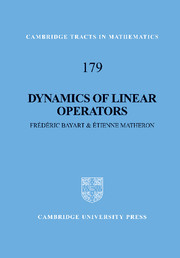Book contents
- Frontmatter
- Contents
- Introduction
- 1 Hypercyclic and supercyclic operators
- 2 Hypercyclicity everywhere
- 3 Connectedness and hypercyclicity
- 4 Weakly mixing operators
- 5 Ergodic theory and linear dynamics
- 6 Beyond hypercyclicity
- 7 Common hypercyclic vectors
- 8 Hypercyclic subspaces
- 9 Supercyclicity and the Angle Criterion
- 10 Linear dynamics and the weak topology
- 11 Universality of the Riemann zeta function
- 12 An introduction to Read-type operators
- Appendices
- References
- Notation
- Author index
- Subject index
12 - An introduction to Read-type operators
Published online by Cambridge University Press: 10 December 2009
- Frontmatter
- Contents
- Introduction
- 1 Hypercyclic and supercyclic operators
- 2 Hypercyclicity everywhere
- 3 Connectedness and hypercyclicity
- 4 Weakly mixing operators
- 5 Ergodic theory and linear dynamics
- 6 Beyond hypercyclicity
- 7 Common hypercyclic vectors
- 8 Hypercyclic subspaces
- 9 Supercyclicity and the Angle Criterion
- 10 Linear dynamics and the weak topology
- 11 Universality of the Riemann zeta function
- 12 An introduction to Read-type operators
- Appendices
- References
- Notation
- Author index
- Subject index
Summary
Introduction
In this final chapter, our aim is to give a short and gentle introduction to the kind of operator constructed by C. J. Read in the 1980s.
In his 1987 paper [202], Read solved in the negative the invariant subset problem for the space l1(N), and in fact for any separable Banach space containing a complemented copy of l1. In other words, he was able to produce on such a space an operator for which every non-zero vector is hypercyclic.
The construction carried out in [202] is something of a tour de force. Moreover, its understanding requires some familiarity with earlier constructions by the same author relating to the invariant subspace problem, which are already quite involved (see e.g. [201]). This convinced us that we should not be overly ambitious regarding the material presented in this chapter. Thus, we have chosen to concentrate on the simplest example of a “Read-type” operator, i.e. an operator T acting on l1(N) for which every non-zero vector x is cyclic. This is a counter-example to the invariant subspace problem for the space l1.
As already said, we have tried to give a helpful presentation, meaning that we have made some effort to explain the underlying ideas as we understand them, inserting heuristic comments whenever this seemed necessary. Some parts of the discussion are deliberately informal, but the construction is nevertheless complete and selfcontained. We hope that this chapter will be useful for people interested in that kind of question.
- Type
- Chapter
- Information
- Dynamics of Linear Operators , pp. 292 - 309Publisher: Cambridge University PressPrint publication year: 2009



